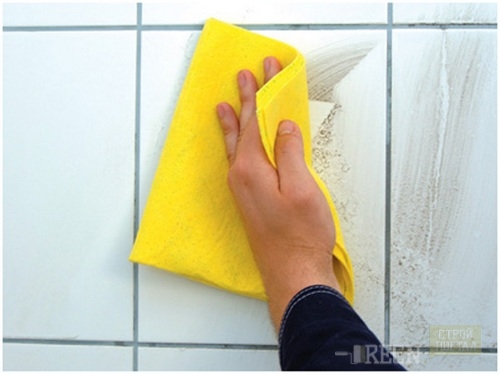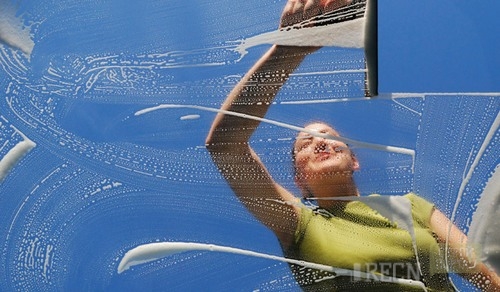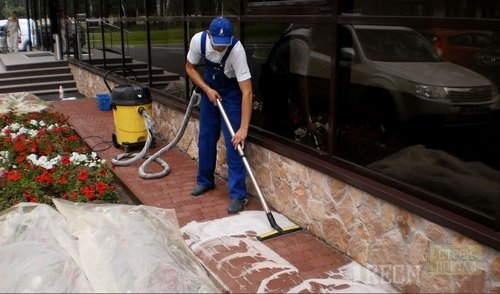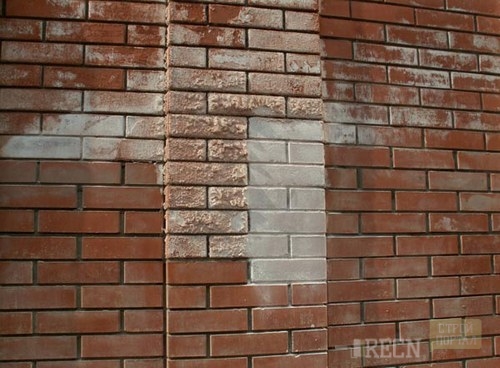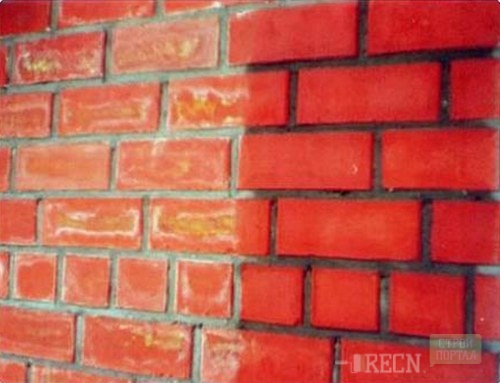
Cement washing. Methods of surface cleaning Useful advice

Cement washing - occupation time consuming and troublesome. The complexity of this process is determined not so much the amount of work, how many specifics of the material itself: the frozen cement is incorporated into the surface of anything. The article discusses the basic solutions to this task.
Content
We will immediately make a reservation that we will "fight" with cement stains in dense clothes, whenever possible closing all open parts of the body, and in rubber gloves. This precaution will save the skin from active solvent actors that are used in removing cement.
So, the main construction work with the use of cement mortar is completed, and the most interesting thing begins - the guidance of order. Not yet frozen strokes and drops of cement, which did not have time to grab, you can scrape a spatula, putting quite a bit effort. If you missed this "successful" moment, get ready to faithfully tinker.
Cement removal from tile
If you have visited the thought to deal with pollution with the help of a nail, hammer or chisel, immediately throw it away - such a "barbarian" method will be justified only in cases where the surface purified does not represent much value.
Tile - a delicate material, ideally all unnecessary traces of the building process need to be removed from its surface immediately. It is necessary to work with the frozen residues of the solution, so as not to scratch the working surface.
- For a start, try removing cement with screwdrivers. Folded in several layers of cloth, or small dense sponge generously moisten means for removing calcareous deposits from toilet bowls. Put this "compress" on a problem place and leave there for several days. Do not forget to re-impregnate the fabric to the cleaning agent when it dries. Alternatively, it is possible to treat a stain with a chloride solution (5% hydrochloric acid) and losing it with an abrasive sponge. If contamination is relatively fresh, it can be removed.
- To purify tiles from cement drops that did not have time to finally grab, also use the usual salt. It is applied directly to the place of pollution, pre-dipped with cold water. After a while, when the stain under the influence of salt will acquire loose consistency, it will be possible to carefully consider a tight brush.
- To remove the solar trails will have to buy a special solvent of the cement mortar, stocking with a spatula, a container with clean water, sponges and rags. Also, for these purposes, special cleaning agents for ceramic surfaces are suitable (for example, Sopro Zea 703 solvent) or a solvent of dried glue. Before proceeding to work, carefully examine the information on the packaging of the purchase agent: the composition of many solvents, chloride or phosphoric acid is included as a active substance, they cannot be applied to some materials. Processing the tiled surface extremely careful, because there is a risk along with unnecessary divorces to dissolve and the necessary thicker seams.
- If you have a soft pill on a drill or bollard, be sure to delete contamination using these tools. In the process of cleaning the tile, they should work at a minimum speed.
Cement Removal from Glass
Cleaning from cement of glass and decorative surfaces involves the presence of a container with water, washcloths and winds, blades, a scraper, a special brush for washing windows, chisels, vinegar and washes for cement residues.
- To begin blot cement contamination sponge soaked in hot water. After one or two minutes, spend the moistener moistened well, after which they are armed with a suitable tool. It may be a scraper for cleansing woor panels. After it, use a special brush to clean the windows.
- Try neatly scraping dry cement droplets with a razor blade. Do not hurry, your task is not to scratch the surface of the glass. To do this, do not consider the cement to the sharp corner of the blade, work only its side cutting plane. Then wash the surface with a large amount of clean water.
- Another popular method of combating cement trails on the surface of the glass is the cleansing of table vinegar. Apply the acid to the necessary sections of the surface and as the cement mass softening is softened with a brush.
Removing cement with paving
First of all, prepare the tools without which you can not do. Pollution from the surface of the blocks is removed with a hammer, a stone whistle, a wire brush, sand, "sandpaper", a cleaning agent based on phosphoric and hydrochloric acid, garden lime or food soda, ammonia and water.
- Try to get rid of cement residues with paving slabs using a hammer and chisel. It is necessary to pick up the cement, but if it does not come out, not everything is lost - we will not sleep with a chisel in the center of pollution, as a result of such a manipulation, its top can crack and disconnect from the surface of the paving. But do not very much if the stain looked down into the tile, "so you only damage it. Opening a wire brush in different directions, consider spots as far as possible. Try again to separate the stain from the chisel paving. Alternate the tools several times in a row. You can test another way of cleaning the surface - to polish it with sandpaper or with a grinding machine. So you cross cement pollution with the level of stone paving slabs.
- If a mechanical method for cleansing a pavement from contaminants was not crowned with success, use the chemical to remove cement with phosphoric acid. A modern range of chemicals to combat cement residues is very large: chop, barracuda, metalin of-c, ecosept 210 and others. Just do not forget to make sure that the "chemistry" does not hurt a stitching, tested the remedy on its small invisible area. Before applying excess phosphoric acid neutralize garden lime ( for this same goals can take little foodie soda, suitable and ammonia). The solution must delay the stain from the tile, the residues can be removed by the brush at the completion of the procedure.
- By virtue of a chemical reaction, hydrochloric acid is superior to phosphoric acid, however if the latter is not coped with the problem, treat stains by means of hydrochloric acid. Before applying it should be diluted with water to the extent specified by the manufacturer on the packaging. Do not flush with the tile means as long as it is dry, then remove the dirt with a brush.
Note!
- Rarely a chemical cleaning agent leaves the color of paving stones in its original form. To "losses" were minimal, apply the cleaning solution exactly at the place of pollution, not allowing it to fall on the clean surface.
- If the pavers were covered with sealant after application of the "chemistry" of its pre-treat the surface of the dried sealer repeatedly. Thus you will be able to return the tiled surface, its "native" color.
- Acid in concentrated form is not used - they are always diluted with water. After applying the cleanser acid-based tile surface was treated with a neutralizer and rinsed with pure water.
Removing cement brick (brick wall)
Purification of bricks of cement - the issue date. Old, stained blots of cement bricks from dismantled masonry can still be useful - most importantly, to give it a "trademark" look. Svezhevystroennaya brick wall with cement stains or slides on the surface also requires at least a minimum of purification.
Despite the visual reliability brick block, careless removal of cement residues can cause damage. We must act deliberately and slowly.
- The most simple way to clean the brick - work hammer and chisel. Carefully shear these tools the biggest "islands" of the solution. When there are no more large pieces, cut the surface of the brick, "sandpaper". For convenience, bring down two wooden slats and fasten sandpaper to the lateral part of the self-made tools. So you can clean the red brick, while its silicate "brother" requires more time and effort.
- To work went quickly, armed with sandpaper and a jackhammer (as an option - drill with spetsnasadkoy). Be careful - in the process protect the eyes, mouth and nose with glasses and a respirator of the inevitable dust.
- Another way to combat cement residues is to place bricks into the water. The cement solution is mounted on the water, so water will act on its remnants as a solvent. Lose some time, then energetically treat the brick surface with a rigid brush.
- High-quality red brick is cleaned by a solution of sulfuric acid. It is diluted with water in a ratio of 1:10 or 1: 7. Keep in mind that the acid is very dangerous, it can provoke the skin burns and the mucous membrane of the respiratory tract. The brick is put into the cast-iron bath, poured the resulting means of cleaning from cement and boil on the bore for some time. As a result of such thermal processing, the remains of cement must dissolve. For silicate bricks, such experiments will not fit - he simply collapses.
- Ready brickwork, contaminated with divorce and cement blusters, treat any concentrated alkaline-based agent from a rich arsenal of auto chemicals. Prepare a diluted detergent solution according to the instructions, impregnate them a dense piece of fabric or roller and evenly apply on the wall. When the laying is driving, rinse the wall with a large amount of clean water.
- Sutitate the brick masonry homemade mixture consisting of sunflower oil and crumbs, which is formed during the sawing bricks with a grinder. Wait for this substance to dry (it takes a lot of time), then use a brush with a brush with a brick.
- Keramic brick is purified by diluted hydrochloric acid. To begin with a masonry with running water, and then carefully wipe the contaminated sections with a cloth moistened with an acid solution. Make sure that the acid does not hit the masonry seams. If this happens, wash the place where the acid will begin to come in the form of plaque, a solution of liquid soap and water.





